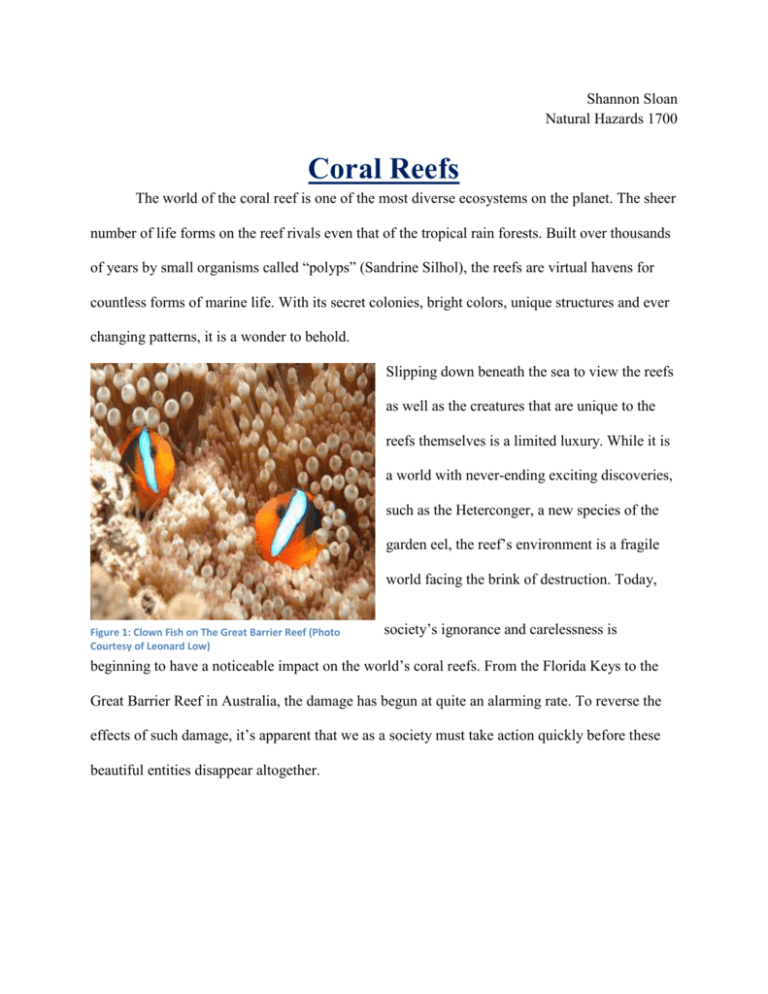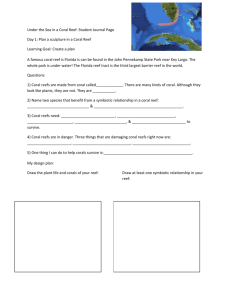Coral Reefs
advertisement

Shannon Sloan Natural Hazards 1700 Coral Reefs The world of the coral reef is one of the most diverse ecosystems on the planet. The sheer number of life forms on the reef rivals even that of the tropical rain forests. Built over thousands of years by small organisms called “polyps” (Sandrine Silhol), the reefs are virtual havens for countless forms of marine life. With its secret colonies, bright colors, unique structures and ever changing patterns, it is a wonder to behold. Slipping down beneath the sea to view the reefs as well as the creatures that are unique to the reefs themselves is a limited luxury. While it is a world with never-ending exciting discoveries, such as the Heterconger, a new species of the garden eel, the reef’s environment is a fragile world facing the brink of destruction. Today, Figure 1: Clown Fish on The Great Barrier Reef (Photo Courtesy of Leonard Low) society’s ignorance and carelessness is beginning to have a noticeable impact on the world’s coral reefs. From the Florida Keys to the Great Barrier Reef in Australia, the damage has begun at quite an alarming rate. To reverse the effects of such damage, it’s apparent that we as a society must take action quickly before these beautiful entities disappear altogether. Mass Destruction After being a highly successful life form for 250 million years, disruptions in the biological and communication systems of coral reefs have been found to be the underlying cause of coral bleaching and collapse of reef ecosystems around the world (Galaxy). Due to changes in ocean temperature, pollution, overfishing, sedimentation, acidification, oxidative stress and disease, and the synergistic effect of some of these problems may destroy reefs even when one cause by itself would not (Galaxy). In a recent study done by the Global Coral Reef Figure 2: Dynamite not only kills the fish that live in the reef, but the reef as well. (Photo courtesy Thomas Heeger: Philippines) Monitoring Network, destruction or threats of coral reefs have increased from 59 percent to a drastic 70 percent since the last study in 2002 (Heilprin). Only about 30 percent of the world’s coral reefs are healthy, down from 41 percent two years, most noted was the fact that the Caribbean has lost 80 to 98 percent of its elkhorn and staghorn coral, two of the region's most common species, the scientists said, suggesting the United States should look at listing them as endangered species (Heilprin). John Turner, assistant secretary of state for oceans and international environmental and scientific affairs, called the report "a wake-up call" (Heilprin). Virginia Weis, a professor of zoology at Oregon State University said, "We've known for some time the general functioning of corals and the problems they are facing from climate change," "But until just recently, much less has been known about their fundamental biology, genome structure and internal communication. Only when we really understand how their physiology works will we know if they can adapt to climate changes, or ways that we might help." http://www.youtube.com/watch?v=4KjxVMqDep0&feature=related Progress Coral reefs are among the oldest and most diverse life forms, they provide food and shelter to fish and protect shores from erosion, they help drive the food chains and economies of many on the planet (Heilprin) and yet they are the least understood. As part of the effort to protect our Nation’s extensive reefs, U.S. Geological Survey (USGS) scientists are working to better understand the processes that affect the health of these ecologically and economically important ecosystems (Michael E. Field). “Scientists worldwide are working to understand the impacts of natural processes and human activities on the health and sustainability of coral reefs. In the United States, this effort is being coordinated by the U.S. Coral Reef Task Force. As part of the task force, the U.S. Geological Survey (USGS) is contributing to the effort to understand the biological and geological controls that affect our Nation’s coral reefs. USGS coral reef research focuses on detailed mapping of reefs, the development of monitoring techniques, and studying reefs’ geologic growth and development and how they are affected by sedimentary and hydrologic processes, water quality, and fishing. These efforts will help provide information that is essential if coral reefs are to be saved (Michael E. Field).” Reflection The world of the coral reefs is home to many colorful diverse creatures with its hidden alcoves of wonders, it itself is alive as well. While I in my lifetime may not get a chance to see to adventure under the sea to view this underwater fairytale, it is something that I wish for future generations of my family to see. The future is now for us in helping to save these beautiful entities. They are currently being destroyed due to overfishing, pollution and an increasing rise in ocean temperature among other things. While I appreciate warm temperatures, it’s apparent that creatures on our earth do not. In my naiveté, I hadn’t thought hard about my carbon footprint. While I casually recycle, it is something that I will endeavor to do more of in the future. While my little bit of recycling may not help a lot, it will help some. I will also appreciate the beauty of the land around me more often as I it may not be there in the future. In researching for a subject it became apparent that if we as a society don’t stand up and take note of the damage we are inflicting on the land around us, we won’t just lose the coral reefs but many other species as well. Works Cited Galaxy, The Daily. EcoAlert: Why are the World's Coral Reefs Dying? 07 October 2011. http://www.dailygalaxy.com/my_weblog/2011/10/ecoalert-why-are-the-worlds-coral-reefsdying.html. 20 October 2012. Heilprin, John. Coral Reef Damage Rising Worldwide. 2004 12 December. http://www.commondreams.org/headlines04/1207-07.htm. 20 October 2012. Low, Leonard. File:Clownfish, Great Barrier Reef, Cairns, Australia.jpg. 01 January 2007. http://commons.wikimedia.org/wiki/File:Clownfish,_Great_Barrier_Reef,_Cairns,_Australia.jpg. 22 October 2012. Michael E. Field, Susan A. Cochran, and Kevin R. Evans. U.S. Coral Reefs—Imperiled National Treasures. 30 October 2008. http://pubs.usgs.gov/fs/2002/fs025-02/. 22 October 2012. Price, Dave. Coral Reef Alert For Earth Day. 22 April 2009. http://www.youtube.com/watch?v=4KjxVMqDep0&feature=related. 22 October 2010. Sandrine Silhol, Gaelle Guerive. Extradordinary Endangered Animals. New York: Abrams Books, 2011. World, Ocean. CORAL REEF DESTRUCTION and CONSERVATION. 2004. http://oceanworld.tamu.edu/students/coral/coral5.htm. 22 October 2012.






